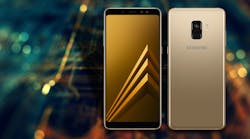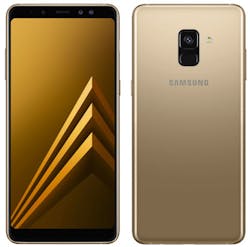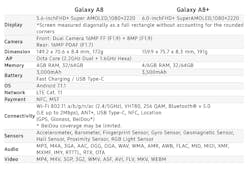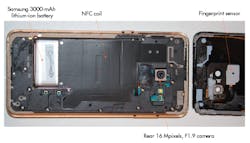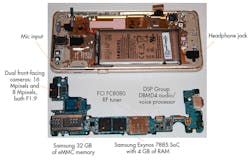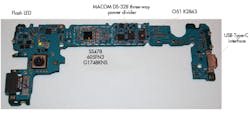After much anticipation, Samsung debuted its Galaxy A8 (2018) and A8+ (2018) as mid-range phones, but with all of the bells and whistles of higher-end devices, from NFC payments to Bixby voice and dual high-resolution user-facing cameras for selfie fans. With Mobile World Congress (MWC) kicking off in Barcelona next month (February 26 to March 1), Electronic Design got hold of one of the first A8s, fresh off the production line, and put it under the knife.
The new A8 and A8+ are similar, differing only in screen size, available RAM, and battery size. The A8 measures 5.6 in., while the A8+ stretches to 6 in. Both use SuperAMOLED Infinity displays with a resolution of 1080 × 2220, come with Android 7.1.1 (Nougat), and are IP68-certified (Fig. 1).
1. The 2018 Samsung Galaxy comes in two versions, differing only in dimensions, battery size, and RAM options (4 GB for A8, and 4 or 6 GB for A8+).
For wireless connectivity, the A8 supports LTE Cat 11 (600-Mb/s download) and has Wi-Fi up to 802.11ac, Bluetooth 5, and GPS. NFC connectivity is provided using a coil on the back, sandwiched between the battery and the back cover (Fig. 2). The fingerprint sensor is centrally mounted, right below the rear camera.
2. The Samsung Galaxy A8 (2018) has the NFC coil between the battery and the back cover.
Removing the back cover required the now typical “heat-and-lift” process as it’s glued around the edges. Under the NFC coil is Samsung’s 3000-mAh lithium-ion (Li-ion) battery.
Push for More Processing
There are plenty of consumer-level reviews of the new A8, mostly positive, with some quibbles with the level of processing available. Having just bought a Google Pixel 2 phone, it’s odd that consumer reviews don’t benchmark a phone’s ability to maintain a phone call. Ironically, it seems a smartphone’s ability to maintain a call is at the bottom of the list of concerns, given the evolving nature of the devices, from communication devices to all-purpose devices.
This evolution to more advanced processing requirements brings us to one of the most important features of the new A8s: the use of Samsung’s much-secreted Exynos 7885 system-on-chip (SoC) (Fig. 3). Samsung refers to this as the Octa Core in its specifications.
3. The processing heart of the A8 is the Samsung Octa Core running at 2.2 GHz. All indications are that it’s based Samsung’s yet-to-be-announced Exynos 7885 SoC in a 14-nm process node.
Though officially unannounced, some leaked details on the Exynos 7885 suggest it uses a 14-nm process and comprises two Cortex-A73 cores running at 2.2 GHz, as well as six smaller ARM Cortex-A53 cores running at 1.6 GHz. For graphics, it uses an ARM Mali-G71 GPU.
With a total of three cameras, two on the front and one in the rear, images and video are clear priorities with the A8/A8+. The dual front-facing cameras have a resolution of 16 and 8 Mpixels, both with an F-stop of 1.9. The rear-facing camera is 16 Mpixels, F1.7.
The level of integration on the new A8 indicate that Samsung’s Exynos may have much more than the seven processing cores on board. For example, some sources indicate the Exynos 7885 has undergone Bluetooth 5 certification, implying that Samsung is bringing some wireless functionality on-chip. More on that as details emerge. For now, this is speculation and may require further updates from us and from ED’s community at large. Add any details to the comments section below and we’ll solve this mystery.
In the meantime, the Exynos (Octa Core) is supported by 4 (A8) or 6 GB (A8+) of on-chip RAM, with the external KLMBG2JETD providing 32 GB of eMMC device storage. Both the A8 and A8+ have a 64-GB option.
Viva Voce
Among the many functions supported on modern smartphones, voice activation and control is increasing in popularity. There are various versions of these increasingly smart virtual assistants, including Siri and Google, but the A8 comes with Samsung’s Bixby. The assistant is always on, by default, and has proven useful for many users.
However, acquiring the voice input correctly and accurately requires a high level of voice- and speech-processing expertise. With DSP Group’s DBMD4 audio/voice processor (part number D4A1A) in the A8, it’s safe to assume that it’s being used for always-on, Bixby-based voice activation, as was done in the Galaxy S7 Edge and the Galaxy Note7 devices.
Intended for smartphones, wearables and Internet of Things (IoT) devices, the BDMD4’s designers emphasized low power. But, to ensure the voice assistant (Bixby) gets the right inputs, DSP Group has refined pre-process algorithms for noise cancellation, beamforming, and echo cancellation.
4. The Samsung A8 combines the entire RF and power-management section into four main ICs. We'll be digging more into what those ICs comprise, particularly the "G1748KNS."
Other recognizable ICs on the A8 include FCI’s (now Silicon Motion) FC8080 terrestrial digital multimedia broadcast (T-DMB) RF tuner and demodulator and MACOM’s DS-328 three-way power combiner (Fig. 4).
For many smartphone users, the A8 punches above its weight performance wise (it weighs in at 172 g and measures 5.87 × 2.78 × 0.33 in.) It has plenty of connectivity, is clearly targeted at selfie-takers, and has a remarkable display. The ability to add more memory using the microSD slot will always be a nice feature.
Though it’s a mid-range phone, it’s priced at about $844, putting it at the higher end of the cost spectrum. However, out of the box, the phone felt good, solid, and easy to use. Bixby worked well and either it became smarter or I became clearer, but its responsiveness and accuracy increased over a matter of days. For some, the larger A8+ is an advantage. When it comes to single-handed use, though, the A8 is more compact and slides into the pocket a little easier. Wireless charging would be a good feature to have, but Samsung’s likely saving that to distinguish its higher-end devices.
